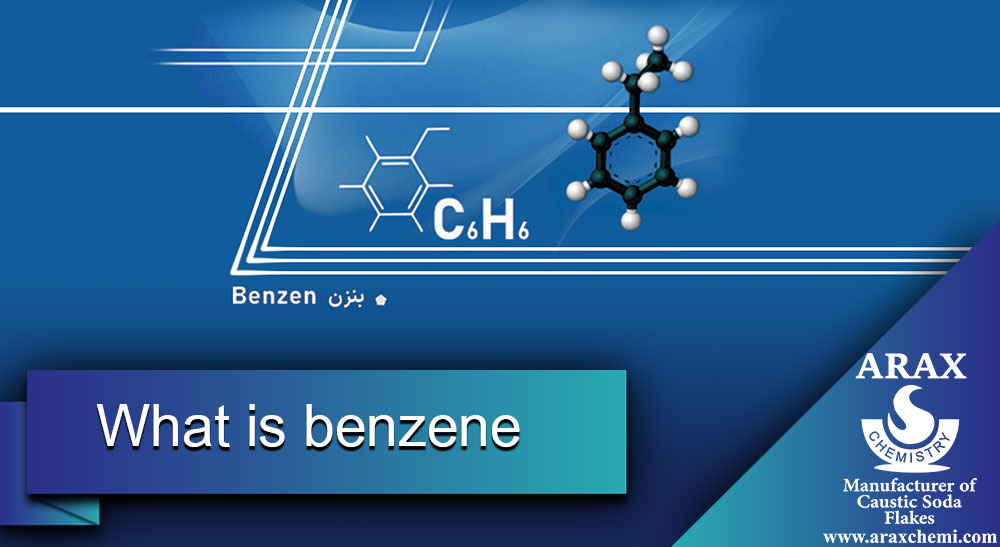Benzene (C6H6) is an organic compound known as an aromatic hydrocarbon. This compound consists of a hexagonal ring with one carbon atom on each side and six hydrogen atoms around them. Benzene, as a solvent used in chemical industry, is a raw material in the production of chemicals and fuel use. It is also used in pharmaceutical industry, dyeing and production of plastics.
Benzene, as a well-known organic compound, can be known under other names. Some other names of benzene are:
1. Benzol
2. phene
3. Cyclohexatriene
4. phenyl hydride
5. pyrobenzol
These names are commonly used in scientific and chemical texts. pyrobenzol is actually a very simple hydrocarbon that consists of six carbon and hydrogen atoms and is found in the structures of many organic compounds and chemical products.
Physical properties of benzene
- Physical form: pyrobenzol is a colorless liquid at standard temperature and pressure.
- Melting temperature: phene has a melting temperature of about 5.5 degrees Celsius.
- Boiling temperature: Cyclohexatriene has a boiling temperature of about 80.1 degrees Celsius.
- Density: The density of benzene is about 0.879 grams per cubic centimeter.
- Solubility property: phenyl hydride can be placed in many solvents such as alcohol, ether, acetone and benzoalcohols. Also, benzene does not dissolve well in water.
- Vapor pressure: Benzol has a strong vapor pressure and evaporates easily. This property makes it a suitable solvent in many chemical processes.
- Odor: Benzene has a persistent and sweet odor that is well known.
- Refractive index: The refractive index of Benzol is about 1.501.
- Electricity: Benzene is a non-conductive substance and does not conduct electricity when it is off.
- Solubility: phenyl hydride is used as a solvent due to its solubility characteristics and solubility properties in different solvents.
Chemical properties of benzene
-
Electron arrangement:
phene has a hexagonal ring with one carbon atom and one hydrogen atom on each side. This ring is electron-withdrawing, but due to internal electron conjugation, electrons are symmetrically distributed in the benzene structure.
-
Electrophilic reactivity:
pyrobenzol has the ability to react with electrophilic compounds due to its aromatic ring. For example, the halogenation reaction of benzene with halogens (such as chlorine or bromine) and the nitration and sulfonation reactions of benzene with acids are examples of electrophilic reactions of phene.
-
Nucleophilic reactivity
: Benzol also has the ability to react with nucleophilic compounds. For example, the alkylation and acylation reaction of benzene with nucleophilic hydrocarbons (such as amines and alcohols) and the sulfidation and oxidation reactions of benzene with oxidant compounds are examples of benzene nucleophilic reactions.
-
Reactions of phenyl compounds:
phenyl hydride, as a raw material, performs many reactions with phenyl compounds (compounds that have a phenyl group -C6H5 in their structure). These reactions include halogenation, nitration, sulfonation, hydroxylation and oxylation.
-
Susonation reactions:
phene can add a sulfonic group to the ring by reacting with
sulfonic acid. This reaction is known as a sosonation process.
-
Halogenation reactions:
Benzol reacts with halogens (such as chlorine or bromine) to form halogens derived from benzene. This reaction is known as halogenation. For example, in the halogenation reaction of benzene with chlorine, chlorine is substituted for one or more hydrogens in the benzene molecule and compounds such as phenyl chloride (C6H5Cl) are produced.
-
Nitration reactions:
Cyclohexatriene can be nitrated in the reaction with nitric acid and the presence of sulfuric acid. This reaction is known as nitration and results in the formation of nitrobenzene (C6H5NO2).
-
Sulfonation reactions:
phenyl hydride can be sulfonated by reacting with sulfuric acid. This reaction is known as sulfonation and results in the formation of benzene sulfonic acid (C6H5SO3H).
-
Oxygenation reactions
: phene can react with oxygen and, under appropriate conditions, lead to the formation of benzoic peroxide (C6H5COOOH).
9 Uses of benzene
pyrobenzol (C6H6) is used in different industries and in different fields. Some of the applications of benzene are in the polymer industry, rubber industry, paint and resin industry, pharmaceutical industry, oil and gas industry, electronics industry, animal and poultry feed industry, glass industry, and cosmetics industry.
-
Polymer industries:
Benzol is used as a raw material in the production of polymer materials such as polystyrene, polyolefins, nylon and polyamides. These polymers are used in the production of car parts, packaging, home appliances, electronics and other industries.

-
Rubber industry:
Cyclohexatriene is used as a main ingredient in the production of synthetic rubber. Tires produced from Benzol are used in the production of automobile tires, clothing tires, industrial tires and other rubber products.
-
Paint and resin industry:
phene is used as a solvent in the production of various paints, resins, and oils. This use includes the production of industrial paints, automotive paints, industrial resins, polyester resins, epoxy resins and related products.

-
Pharmaceutical industry:
phenyl hydride is used as a solvent in the production processes of drugs and medicinal chemicals. pyrobenzol can be used as a solvent in the extraction and processing of various substances, the production of pharmaceutical products and raw materials of drugs, as well as in synthetic processes.
-
Oil and gas industry:
Cyclohexatriene is used as an important material in the oil and gas industry. It is used as a solvent in oil extraction and refining processes. Also, benzene is used in the production of gasoline, hydrogenated fuels and other petroleum derivatives.

-
Electronics industry:
phene is used as a solvent in the production of electronic materials. This includes the production of solar cells, transistors, electronic displays and semiconductor materials.
-
Animal and poultry feed industry:
Benzene is used in the production of additives and vitamins for the animal and poultry feed industry.
-
Glass industry:
phenyl hydride is used as a solvent in the production of glass and related products such as glass fibers.
-
Cosmetic industry:
Cyclohexatriene is used in the production of cosmetic products such as perfumes, lotions, creams and skin care products.
These are just some of the uses of Benzol, and there are many more. It should be noted that benzene is a toxic substance and should be used carefully and appropriately.
Benzene production methods
Catalytic reforming
In this method, a group of hydrocarbons are combined with hydrogen in the presence of catalysts such as platinum chloride or rhodium chloride. This method is performed at temperatures between 60 and 200 degrees Celsius and a pressure of 8 to 50 atmospheres, and its final products include Benzol.
Disproportionate distribution of toluene
This method is used as a suitable replacement for hydroalkylation methods in units that intend to produce both toluene and xylene.
Toluene hydroalkylation
In this method, toluene is converted to phene.
Steam cracking
This method is used to produce ethylene and other alkenes from linear and large hydrocarbons. Benzene is also produced as a byproduct in some reactions such as gasoil pyrolysis.
Benzene in the environment
Air in various environments can contain small amounts of phenyl hydride, which may come from a variety of sources. Some of the major sources of benzene in the environment include:
-
Cigarette smoke:
Cigarettes contain Benzol, and as a result, cigarette smoke can also be a source of Cyclohexatriene in the air.
-
Car service stations:
In these stations, the fuel and oil used in cars contain benzene. Benzene may be released into the air from these stations if the fuel handling or handling process is incorrect.
-
Smoke from motor vehicles:
The exhaust output of motor vehicles contains Benzol. Older vehicles and older technologies usually have the highest amount of benzene in their exhaust fumes.
-
Chemical industries and products:
Some chemical industries such as paints, waxes, cleaners and sealants contain phenyl hydride. If these industries are not properly controlled and managed, benzene can be released into the air.
-
Hazardous waste and gas stations:
Hazardous waste such as chemical waste and gas stations may contain high levels of Benzol.
-
Working in industries related to benzene:
In some industries where phene is used or produced, such as the oil and petrochemical industry, the presence of benzene may be felt in the work environment.
Therefore, to reduce exposure to benzene in the environment, it is necessary to follow health and safety standards and guidelines and take appropriate precautions in environments that may contain benzene.
Benzene and human health
Inhalation of large amounts of phene can lead to real and life-threatening consequences for many people. Inhaling Cyclohexatriene in large amounts can cause serious symptoms and complications, including the following:
Acute toxicity: Inhalation of large amounts of phenyl hydride can cause acute poisoning and in some cases may lead to death. Nervous disorders: Benzol can cause drowsiness, confusion, increased heart rate, headache, tremors, convulsions, and even anesthesia. Effects on the blood: Benzene can have harmful effects on the blood in the long term. This substance can reduce the production of red blood cells and eventually lead to anemia. Effects on the immune system: Benzene can cause profuse bleeding and have effects on the immune system, which may lead to further contamination.
last word
Benzene is a toxic chemical compound that can be found in various environments and can threaten health and health through inhalation and consumption of foods containing it. Inhaling benzene in large amounts can cause serious side effects, including drowsiness, confusion, increased heart rate, headache, tremors, convulsions, and even anesthesia. Also, consuming foods containing benzene can cause complications similar to its inhalation. In addition, long-term exposure to Cyclohexatriene can lead to serious problems in the blood, brain, and bones. Therefore, it is necessary to avoid long-term exposure to Benzol and take necessary safety and health measures.
